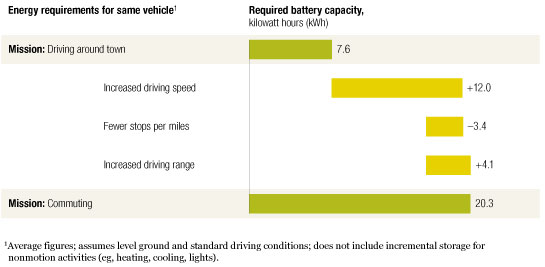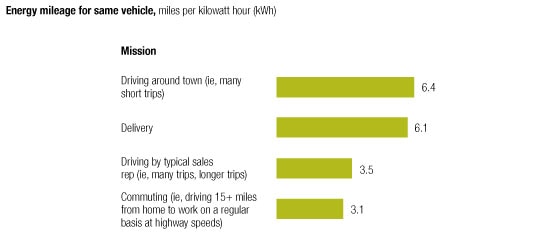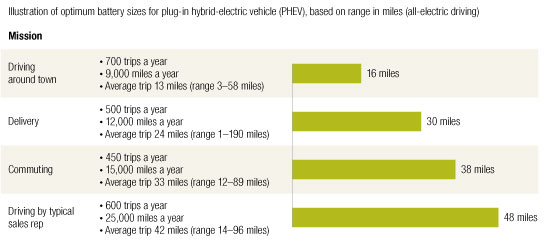Global carmakers are trying to define a future market for electric vehicles. To reach beyond affluent, environmentally conscious, or technically enamored buyers, these companies will need to develop products that satisfy the consumers’ main concern—good value for money. Given the current cost of energy storage, that is a considerable challenge.
A recent McKinsey study suggests that one way companies can achieve this goal would be to focus on tailoring battery-powered vehicles to the actual driving missions of specific consumers—that is, to the way they use their vehicles. Most existing gasoline-fueled cars, as well as many electric ones now on the drawing boards, are intended for multiple driving missions of differing lengths and speeds. By focusing on specific driving missions of consumers, a company can match a vehicle’s energy storage requirements to a consumer’s particular needs and thus design more economic vehicles. It can also shape its brand and advertising messages and go-to-market strategies for such products more efficiently.
Our study, which focused on typical driving missions in the United States, examined the factors underlying the energy storage requirements, and thus the costs, of car batteries. We divided energy use into two major categories: the energy required, first, by the vehicles’ physical characteristics (such as rolling resistance and mass) and, second, by the way the vehicles are used (such as driving distance, speed, and the frequency of stopping and starting). It is well understood that the addition of incremental energy storage increases an electric vehicle’s cost substantially. (That isn’t true for gas-fueled vehicles, since a larger gas tank is almost cost free.) But we found that the energy storage requirements of cars used for different missions could be vastly dissimilar, even if their size and total number of miles driven remained the same. Driving missions—much more than the size of vehicles—determine energy storage requirements.
Let’s consider two common missions: driving around town and commuting. The latter’s substantially higher energy storage requirements don’t come mainly from the greater range required by a commuting car. Rather, the most significant factor is the higher average driving speed, and thus air resistance, encountered on freeways (Exhibit 1). The clear implication is that battery-powered vehicles suitable for the most energy-intensive driving missions, such as commuting, will overserve consumers who use their vehicles for shorter trips at lower speeds, such as running errands around town. Such vehicles won’t deliver the right value at the right cost.
The driving mission

The reasons for focusing on the around-town market go well beyond shorter driving distances. Compared with vehicles powered by internal-combustion engines, battery-operated ones get better energy mileage (miles per kilowatt hour and thus per unit of energy storage) when driven at relatively low speeds on local streets, with a lot of stopping and starting (Exhibit 2). Representative driving missions include cars used in cities and in short-range suburban driving, as well as delivery vans and, perhaps, taxis. By our estimate, up to 38 million US households could purchase such a vehicle. The evidence is that they own at least two cars (so one can be used for more demanding activities), at least one has low annual mileage, and the households’ annual incomes suffice for electric vehicles.
Energy use differs

Battery electric vehicles aren’t appropriate for all consumers or households, of course. Some require the extra range of plug-in hybrid-electric vehicles (PHEVs; cars and trucks that can run on electric power but also have small internal-combustion engines as backup). Here too a segmentation by driving mission is critical to make the economics of vehicles attractive. Exhibit 3 illustrates the operating cost of plug-in hybrids with distinct battery sizes suited to four representative driving missions, each of which involves different ranges of total annual miles and different distributions in trip lengths between each chance to charge the battery.
Segmenting by mission

A segmentation by mission frees consumers from the need to pay for bigger cars and batteries than they actually need. Depending on how consumers use their vehicles, the battery size requirements (and thus upfront capital costs) and operating economics can vary quite substantially. The optimal battery size required for a plug-in hybrid driven around town is one-quarter that required by a sales rep.1 More important, the cost of the batteries is in proportion to their size—and at today’s current battery cost of $750 or so per kilowatt hour, size can translate into significant savings, sometimes many thousands of dollars. One implication is that companies offering only a plug-in hybrid with, for example, 40 miles of all-electric range may be undercut by manufacturers of much less expensive vehicles with just 10 or 20 miles of electric range and only marginally higher operating costs. This is because it is much less expensive to use gasoline to cover infrequent trips that exceed a PHEV’s all-electric range than to carry “spare” battery capacity.
Focusing on designing and selling battery-powered vehicles to segments with specific driving missions also allows carmakers to articulate the values clearly to target buyers and to focus distribution strategies. While some automakers are taking this approach, many others are attempting to design vehicles that satisfy the needs of 95 percent of all customers. Our research suggests that these carmakers should be thinking in radically new ways about market segmentation.
